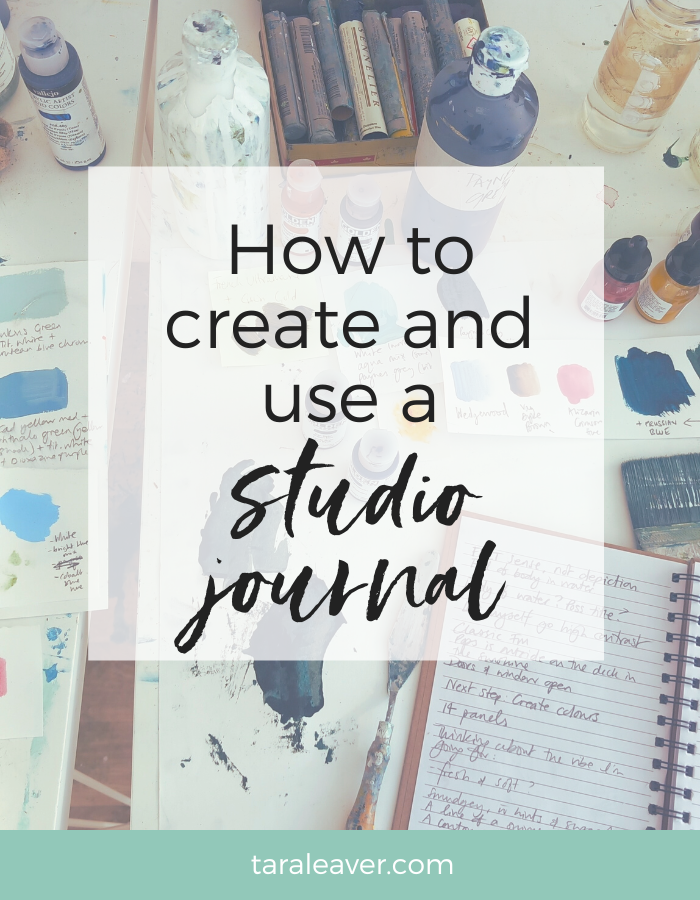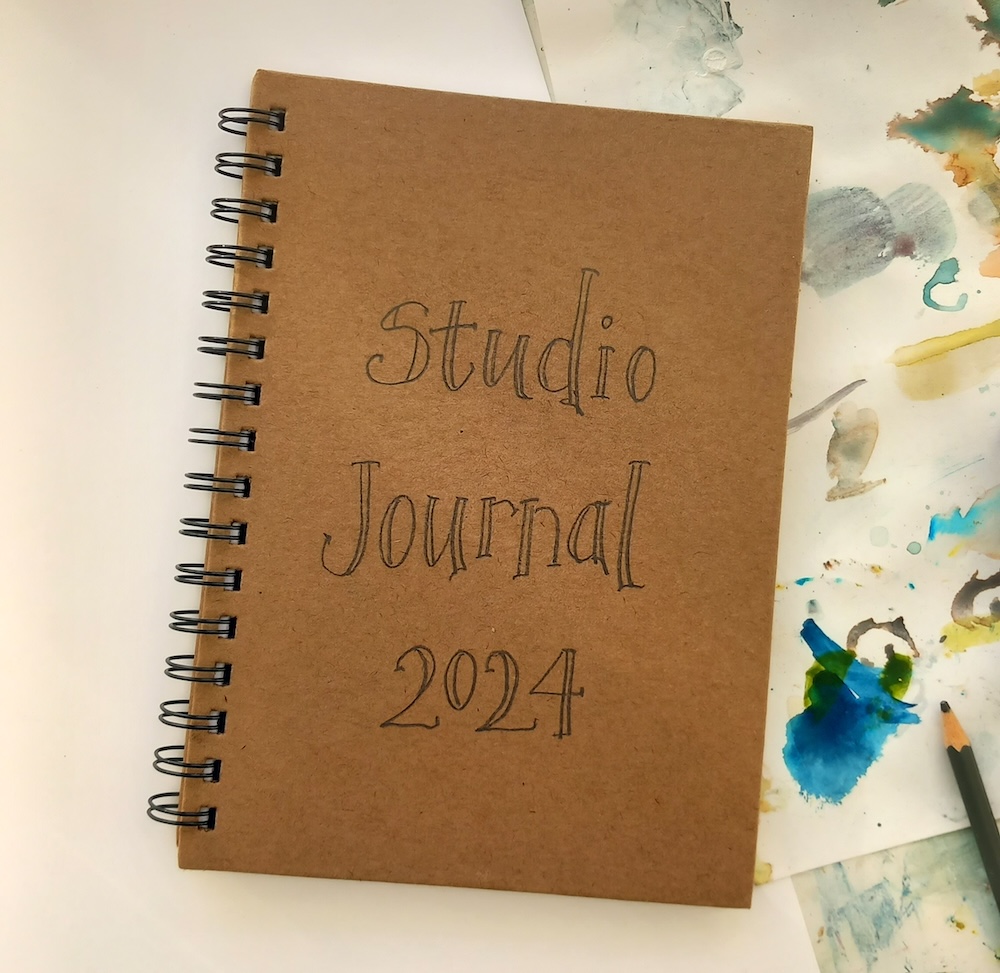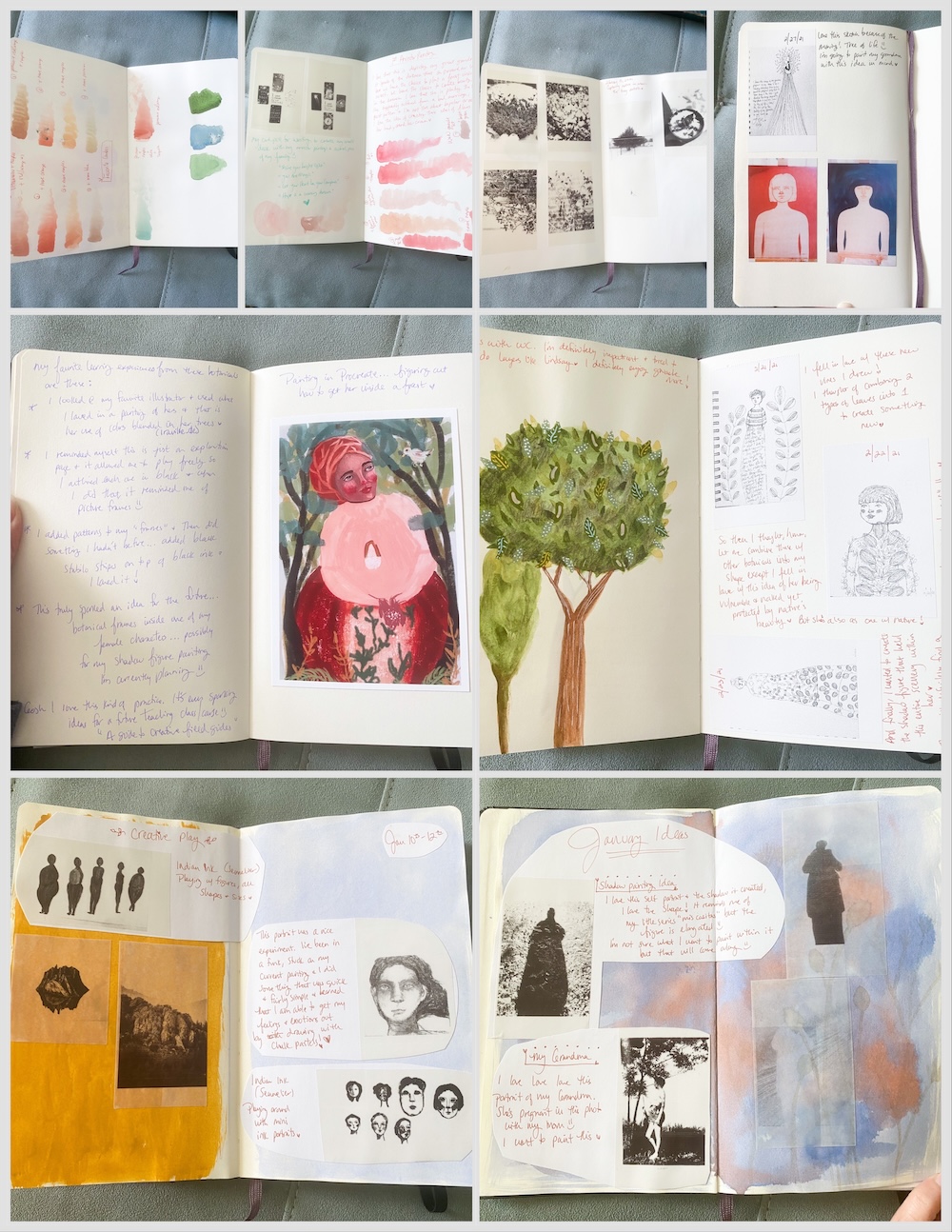
Do you have a studio journal?
Despite being someone who has written a journal in some form for most of my life since the age of eleven, I’ve never kept one specifically for my studio practice.
I write about my art in my daily journal, but the insights get lost and diluted amongst the rest of the experiences, thoughts, and feelings I record.
I’ve made sporadic notes in sketchbooks over the years too, but nothing that really stuck.
Then, during a conversation in the Happy Artist Studio, in which one of our members talked about keeping a studio journal last year and how helpful it was for her, something finally clicked.
I decided to try it for myself, and it’s already proving significantly useful!
Two tips if you’re thinking of starting your own studio journal:
- Get an inexpensive notebook {to avoid fancy-sketchbook-that-never-gets-used syndrome} – spiral bound is good so it will lie flat.
- Spend a little time upfront thinking about how you’d like to use it, and what kind of things you might like to record in it. See below for ideas.
As you can see , I also wrote on the front of mine to make it official. 😉

I’ve used it for all my painting sessions so far this year, and I’m loving it!
My natural inclination is towards rambling prose, but in my Studio Journal I’m exploring different ways of recording my thoughts.
{Because I want most of my limited studio time to be focused on painting!}
☀️ I draw a sunshine if it’s a sunny day, because of how much the sun impacts not just my mood, but my ability to think and see clearly.
⏰ I write the time when I start and the time when I finish, so I can track how much painting time I’m getting in.
Here are some other things I’ve been jotting down that might give you some ideas if you’re thinking of starting or developing your own studio journal:
- painting title ideas
- adjectives for how I want the paintings to feel to help me stay on track
- colour mixes I’m using
- questions to provoke deeper thought about my ideas so I can take them further
- notes on what’s working and how I’m getting myself out of pickles
- little thumbnail sketches to try out shape and composition ideas
- notes on how each session went {it can be helpful to see what mood I’m in and how that impacts the session}
- reminders to future me about what I want to do next time
… and anything else I feel like committing to paper.
Already, it’s proving to be a bit of a game changer:
If I go in and feel unsure about where to begin, I can check my Studio Journal.
When I have a painting lull and feel my mind wandering, I can leaf through the journal or make some notes.
{I’m finding this helps me stay in the creative zone – and the studio – in a different way, when the painting energy ebbs for a bit. Then I’m ready to dive back in, where before I might have ‘just’ run up to the house to do something.}
It’s a lovely way to bookend a session – a few notes before I start, and some thoughts and a time check at the end to round it off.
I know lots of artists keep studio journals, and am so curious about how and why we use them, since they’re all likely to be the-same-but-different.
So I asked my Artnotes readers if they keep their own, and if so how, why, and all that good stuff.
There were some great responses, full of ideas and possibilities we can all play with, and a couple of artists kindly allowed me to share theirs below.
“I kept a studio journal when I was working on a series/body of work. Since then I haven’t kept up with a studio journal but have been contemplating it recently and to use it not for a body of work but just a keepsake of what I’m learning this year. You have inspired me to give this thought the green light! Lol!
Here’s a collage of my studio journal I did that one time. I used a thermal printer on sticker paper to keep pics of sketches and pics that related to my series.

I also used a small picture printer (4×6 inches photos) to keep progress of art pieces in this journal. So no matter where I was sketching or painting, I could have it all in one place and make notes.
I kept color palettes I was working with, thoughts, and even pics of card pulls (Oracle/tarot) I did while working on this series.”
– Jennifer Perry @karmasjourney
“I love the ideas of journaling but for some reason, I can never be consistent with it. Lately I’ve been keeping a notebook in my studio and just write down the total amount of time a piece takes. Out of curiosity and may help with pricing and with the dreaded question “how long does it take you to do this?”.
I keep a semi-regular personal journal in my computer that synchs with my phone and I can add photos of my day.
Probably the closest thing to the Studio Journal I keep is the blog on my site. I know it is public but I don’t think very many people read it and it kind of keeps me accountable. If I wrote in my blog that I’m going to do or want to do something, I probably should do it. I’m going to go right now and add an entry 🙂
This year I created a mini journal with my art that people can print out at home for free. The original idea was to be a gratitude journal and everyday, write down the one thing that you are grateful for. Then I realized that it can be used to write down that one thing you want to track this year.
– Aynex Mercado, Journaling One Thing a Day
The key to making a Studio Journal work for you is to create it to serve and support you and your unique approach and needs.
One artist might want to write a lot of details, or track specifics over time, while another might find that stifling and prefer a few scribbled notes or diagrams as and when.
Judging by the responses to the original Artnote, a common issue is starting a journal, notebook, or sketchbook, and then finding it peters out, or that you lose track and sort of give up and feel vaguely annoyed about it. 😊
For me, the ‘solution’ to that is to create a studio journal that contains only what is useful or interesting to you, knowing that you may change your mind about that tomorrow.
We can let our Studio Journals evolve with us, and that includes deciding that we no longer want to continue with them, or want to take a break, or use them in a different way.
It’s your practice, you get to decide!
Do you keep a studio journal? How do you use it? Let us know your tips and experiences in the comments!







I think I started my journal by accident. Reading this post I can now put a name to what I am dong in my “book/sketchbook”.
I don’t keep a sketchbook but I have just started keeping one of these you describe !
Thank you for the light bulb moment.
Haha, an accidental studio journal, love it!
Some years ago I started a separate Studio Journal notebook because someone online suggested it. While using it, I realized that the form and content of the notes is basically the same as my main sketchbook, I was just doing it on crappy paper.
I’m back to my usual sketchbook journaling, since I’m actively trying to reduce the number of sketchbooks I have going on at a time. There’s just way too many.
Hi Nela, lovely to see you dropping by! Amazing what clarity we can gain from switching something up or trying a different way!
I’m often lurking, just rarely adding my 2 cents if I have any 🙂
Haha! Always appreciate your two cents. 😊
I have never kept a journal (or sketchbook for that matter). I’ve tried keeping a diary many times throughout my life but never actually stuck to it for more than a couple of entries. And as diaries and journaling are sort of siblings I’m not surprised it hasn’t hit home.
I love the idea of writing in a journal but it just doesn’t fit in with how I operate.
I was reading the blogpost and wandered off into Aynex’s webpage. I was so touched and impressed by her presentation (about me page). What a lovely way to introduce yourself!
Just had to come by and say it! 😊
Aynex would be happy to hear that I’m sure! And agree, not everyone expresses naturally through writing; it’s something that’s very normal for me which makes it easier to think in terms of keeping a studio journal. Your artist books are another way!
Oh wow so nice to hear you enjoyed my About page. I’m pretty proud of it. 🙂 Sometimes I get bursts of writing inspiration. Not always. I always try to keep a journal but it never consistent and then I feel guilty about it. I came back to this page to make some notes about keeping a studio journal to see if it sticks this time. I’m working on a series and I know when I exhibit it, I will do artist talks about it. Keeping a journal will help me remember of what I was thinking/struggling with while working on it.
I love that use for a studio journal Aynex! Also nice to see you here. 😊 All the best with your series!
I just bought myself an inexpensive, but still quite beautiful, book for this very purpose and it excites me so much to think about the progress I will get to witness in this book as I fill the pages.
Like you, Tara, I have kept an all-in-one-journal for many, many years, but as I have increased my art-making time and commitment I have felt the need to keep the art related entries in a separate book. I already know it will be important for keeping momentum in my art-making.
On the first page I have made a list over all the things I can think of in terms of how I’ll use it. For example:
– Keeping a record of what I like and don’t like
– Noting take aways from art-making sessions
– Notes from courses I take
– Recording dreams and hopes in regards to my art
– Motivational quotes
– Project ideas
– Evaluating paints, methods, tools and materials I use
– Painting title ideas
I loved reading this Camilla! Firstly the point about momentum – I think it’s helping me with that too. Also your tip about having an index of sorts in the front, with the ideas for what you’ll put it in it. Thank you for sharing this!
I love the studio journal idea. I took a class about two years ago on surface pattern design (taking your art and putting it on products or fabric so mostly computer based learning) and at the beginning of the course the instructor taught a section she called “heartstorming” with steps to go through to take an idea and develop it further into a series. It was meant for creating a cohesive collection of patterns but I loved the exercise so much I started using it to plan out a series of paintings. This method is exactly what you are talking about with a studio journal. Before you begin painting anything you would write out the theme or general idea, then do a 10 to 20 word association, focusing on feelings, memories or what this theme or idea makes you think of. Then you develop a color palette (this part can shift and change as you work of course). Then you do a few thumbnails for composition and to develop the ideas. Once you’ve gone through this exercise I found it was so much easier to jump into painting! I had a road map essentially to guide me while I worked and if I got lost I could refer back to the notes.
Heartstorming! Love that. And how funny that I naturally created that process – I guess it just makes sense! I really like that idea of thinking of it as a road map too. This is great, thank you for sharing this Christina!